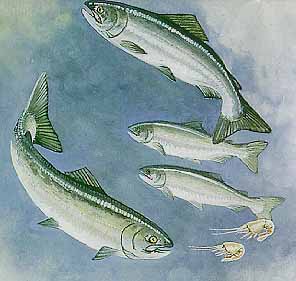 |
 |
Bibliography | Home |
Salmon Life Cycle: Early Stages
![]()
From the U.S. Fish and Wildlife Service brochure: Salmon of the
Pacific Coast
Illustrations © 1994 by Shari Erickson
 |
Reaching the estuary, an area near the ocean where fresh and salt water mix, the young salmon linger to allow their bodies to adjust to salt water. They feed voraciously. The larger a young salmon grows before entering the sea, the more likely it will survive. Finally, they head out to sea. Some species, such as coho, stay in coastal waters, while others migrate more that 2,000 miles to feeding grounds in the north Pacific. |
Challenges: Smolt Migration
|
|
| Salmon live in the ocean for 1 to 7 years. Pacific salmon range as far south as Monterey, California and as far east as the coast of Siberia. When conditions are right, an unknown signal tells them to begin the migration home. Somehow they find their way across thousands of miles of ocean, even in overcast weather, when sun and stars cannot help their navigation. Reaching the coast, they pick up the scent of their home river with noses so sensitive that they can detect dissolved substances in parts per 3,000,000,000,000,000,000! |  |
 |
Once they enter fresh water, the salmon stop feeding. Their stored fat and muscle must last long enough to take them past numerous obstacles, and sustain them while they build nests, fight for dominance, and spawn. They undergo many physical changes: bright spawning colors appear, the males of some species get humped backs, hooked jaws, and sharp canine teeth. The digestive tract degenerates, and the ability to fight disease and heal injuries declines. |
Challenges: Adult Migration
|
|
![]()
| Salmon and Steelhead Life Cycle: | Early Stages | Adult | Spawning |
| Salmon and Steelhead Habitats: | Freshwater | Ocean |
![]()
| www.krisweb.com |